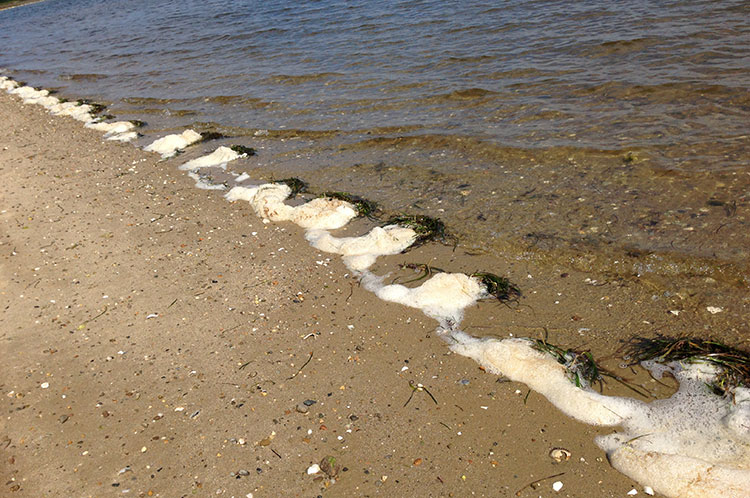• by Dr. Sarah Oktay, Director, University of Massachusetts Nantucket Field Station •

One of the most common questions I get each year is: “What is the foam I see on the water in the harbor or in salt ponds like Sesachacha or Hummock Pond?” This foam looks alarmingly like churned up pollution or detergent. Fortunately, seafoam is actually a safe and natural component of sea water and one of the most important reservoirs of carbon in our natural world. The seafoam is created when dissolved organic matter, called DOM by chemical oceanographers, is mixed with air to form bubbles by the wind and waves.
When small marine plants and animals called phytoplankton and zooplankton die in the water column, their cells are lysed or cut by bacteria and viruses and their organic material spills out into the water column. These particles are also dispersed during sloppy grazing which is exactly what it sounds like, fish and tiny zooplankton ingesting smaller plants and animals don’t use a fork and knife or a napkin so they make a huge mess that floats around in the ocean. Even tinier creatures, many smaller than a human hair (100 microns or micrometers) swim around in this stew and ingest the sugars and other good stuff. This loose carbon associated material or DOM mixes with ocean water and is often concentrated in bands of convergence zones by waves. This water contains a soup of proteins, lignins (tough cell wall material found in wood and some algae), and lipids (fats) derived from sources such as the offshore breakdown of algal blooms. These compounds can act as surfactants or foaming agents. As the seawater is churned by breaking waves in the surf zone adjacent to the shore, the presence of these surfactants under these turbulent conditions traps air, forming persistent bubbles that stick to each other through surface tension. Due to its low density and persistence, seafoam can be blown by strong on-shore winds from the near shore area onto the beach.
After several days of chop, especially after or during a productive spring or summer algae bloom, seafoam is more noticeable. Oceanographers measure the amount of seafoam in water to determine how productive it is. In this case we don’t mean productive as in ability to generate widgets in x amount of hours, but productive as in how much photosynthesis is occurring and how much life can be supported. On ocean research vessels we sometimes use columns to bubble air through seawater and measure the height of the foam which is equivalent to the amount of organic matter. Other times we extract and weigh the carbon and use equations to relate that to the amount of material in the water.
Although DOM is in oceanic and harbor and marsh (brackish mid salinity) water all the time, the concentrations of DOM go up after an algae bloom occurs. When large blooms of algae decay offshore, great amounts of decaying algal matter often wash ashore. Foam forms as this organic matter is churned up by the surf. The Encyclopedia of Earth’s web page describing Marine Dissolved organic matter does an excellent job of synthesizing the basics about this important pool of carbon (http://www.eoearth.org/view/article/154471/): “Marine dissolved organic matter (DOM) is important in the global carbon cycle and marine food webs, and it affects the penetration of light, the exchange of gases at the sea surface and the availability of trace metals and other nutrients to biota. The world ocean is one of the largest reservoirs of actively cycling organic carbon on Earth, and most of the actively cycling organic carbon in seawater resides in the operationally-defined dissolved phase.” This is a big fancy word for saying they call something dissolved if it fits through a filter that is 0.45 microns in size; anything that goes through that pore size (or in some cases a slightly smaller one that is 0.22 microns) is considered “dissolved”. To a chemist it is just a soup of very small molecules but not as completely dissolved as NaCl or sodium chloride, better known as salt which dissolves or disassociates to be Na+ and Cl- ions.
The amount of dissolved organic carbon in seawater (700 Pg; one Pg [petagram]=10 X 10^15 grams=one billion metric tons) is similar to the amount of carbon in atmospheric carbon dioxide, so getting a grip on the factors that control how marine DOM is created, packaged and consumed or dropped out of the system is an critical part of understanding how we adapt to higher amounts of carbon dioxide in the atmosphere. Marine plants can take up excess CO2; the trick is in “sequestering” the carbon and keeping it from being re-released. You might not know, but all materials on earth (or essentially most materials except matter coming in from space) is recycled in our sediments in the ocean, in the earth magma or ejected by volcanoes and pretty much everything goes through a big conveyor belt from atmosphere, ocean, mountains to be eroded into rivers, turned into soil or plant and animal life, deposited into oceans, eaten or used by marine life, pooped out and down to the sea floor to be recycled once again. Everything we are made of is all connected and at one time was part of something else.
When you look at the sea foam in the ocean, you are looking at one of the largest active, organic carbon reservoirs on earth. What this means is this represents more carbon than all the rainforests or salt marshes or corals reefs in the world. As mentioned above, the global volume of carbon stored in the DOM (662 billion tons) is comparable with the total volume of carbon in atmospheric carbon dioxide (currently 835 billion tons) and in land plants (610 billion tons). It is greatest than the volume of carbon stored in living marine animals, plants and bacteria (some 3 billion tons) by a factor of 200 (http://www.awi.de) . That is a lot of carbon and if we hope to adapt or fix the carbon excess in the atmosphere, we will need the help of DOM in the ocean. So cheer on that foam!
Not all sea foam is a good thing though, sometimes it can signal when things have gone out of whack, especially if the foam occurs in great quantities in nearshore areas following large algal blooms which can be harmful. From the National Oceanic and Atmospheric Administration’s website: (http://oceanservice.noaa.gov/facts/seafoam.html accessed July 28th 2014) “Most sea foam is not harmful to humans and is often an indication of a productive ocean ecosystem. But when large harmful algal blooms decay near shore, there are potential for impacts to human health and the environment. Along Gulf coast beaches during blooms of Karenia brevis, for example, popping sea foam bubbles are one way that algal toxins become airborne. The resulting aerosol can irritate the eyes of beach goers and poses a health risk for those with asthma or other respiratory conditions. Scientists studying the cause of seabird die-offs off California in 2007 and in the Pacific Northwest in 2009 also found a soap-like foam from a decaying Akashiwo sanguinea algae bloom had removed the waterproofing on feathers, making it harder for birds to fly. This led to the onset of fatal hypothermia in many birds.”
Fortunately these instances are relatively rare and it is perfectly safe and there is no need to call the authorities if you see these suds on our harbor and bordering shores. Thank those little messy eating creatures for using up some of the excess carbon dioxide in the atmosphere and for recycling our carbon. Next week we will learn about how a salt marsh goes about its day. More on the carbon reservoirs can be found at http://www.whrc.org/global/carbon/residual.html.


